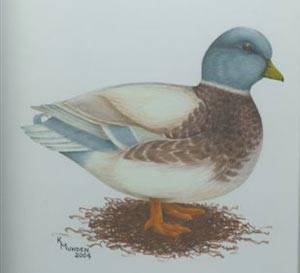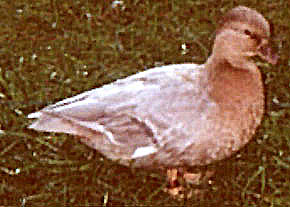 |

|
Currently there are no events or updates to display. |

Calls: One Judge's Perspective Part 2
Calls: One Judge’s Perspective Part 2
By Lou Horton
Of all the Call varieties since the original Whites and Grays, the Butterscotch is easily my personal favorite. The female color pattern is not only unique but it is also complex and beautiful. It all starts with two butterscotch eye streaks on each side of her head and continues with the distinct butterscotch band that runs down the back of her neck. The butterscotch stippling on the breast (called speckling in the ABA Standard) is superimposed over the cream overall base color and the delicate lacing on the back completes the highlights of a plumage pattern which can be frustrating to perfect but at the same time is most striking. The most common color flaw in the female begins with those eye streaks or lack thereof. There should be two and they should be very distinct. As a longtime Butter breeder, I can tell you that once lost (because one used females with indistinct or missing eye streaks or males out of such females regardless of other outstanding qualities) it is very difficult to re-establish that characteristic. A total lack of eye steaks in the female is, therefore, a disqualification in the Butterscotch Call.
Ideal Butterscotch Call FemaleAnother common color flaw is a blue rather than cream base color over the back. A lack of distinct butterscotch lacing in that area is also often seen. The male color pattern is somewhat similar to that of the Snowy and even has some similarities to that of the Pastel male pattern. A frequently seen color defect in the Butter male is a head/neck color which is too dark rather than the pastel blue called for in the Standard. A loss of color or fading of the blue color at the lower jaw area is also common. Another flaw which is quite frequently encountered is a lack of extensive “frosting” on the claret flank coloration. The breast claret feathers should also be liberally frosted with cream color.
Ideal Butterscotch Call Male Unlike the Pastel and Snowy Calls which are often crossed with Grays to improve type, I am unaware of any cross which will truly duplicate the authentic Butterscotch color pattern in female offspring. That means that there is no “quick fix” for type or size problems.
A 2001 hatch Pastel Call from Acorn Hollow The Pastel Call was introduced by the renowned Call breeder M. G. Oakford who also introduced the Snowy color pattern in Calls.The “Pastel” name was a very apt description especially of the female. The base color of the female’s plumage is a rich golden brown. The back of the female’s neck is marked with a darker brown band that actually starts at the crown of the head. It is not quite as distinct as that of the female Butterscotch because of the difference in base coloration. The base color of the female over its back changes to a silvery gray lightly penciled with buff.One pet peeve of originator Graham Oakford in terms of Pastel male color flaws was a bill color closer to the olive than to the “apple green” specified in the Standard. The bean of the bill should be dark but Oakford objected to specimens which had black patches in other areas of the bill. He felt that the drake’s bill color was a unique characteristic and it should not be lost or degraded. Last but not least, Oakford stressed that the drake’s bib should be clean and not ragged or allowed to extend to the bird’s flanks.Breeders have generally done a good job of eliminating the only two disqualifications related specifically to Pastels: the previously mentioned extension of the male’s bib color into the thigh coverts and a definite white neck ring or white chin in the female.Next time: the Snowy Call.
Originally published: 12-19-2014 Last updated: 02-03-2017 |
Copyright © 1997 - 2025 Acorn Hollow Bantams. All Rights Reserved. | Terms of Use | Privacy Policy




